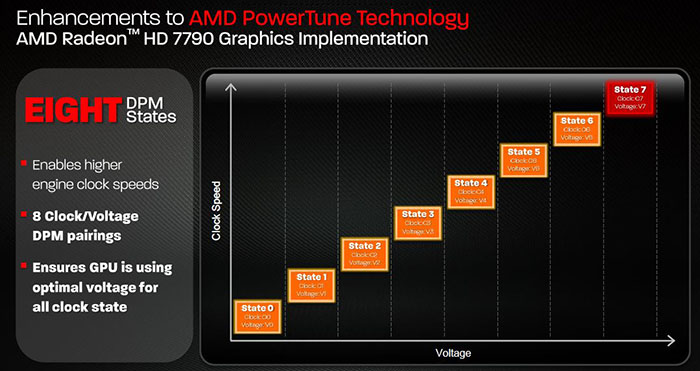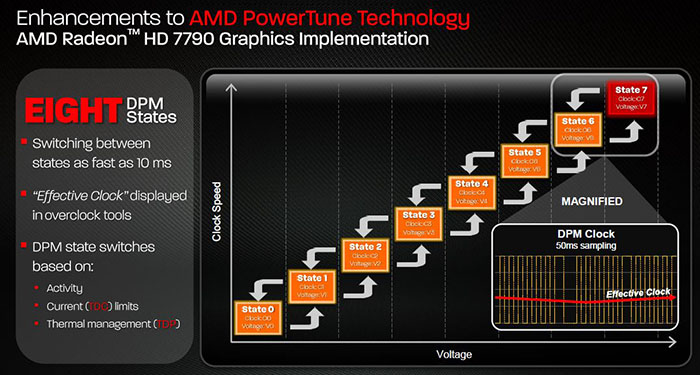A new hope
AMD is today introducing a mainstream graphics processor that is purposefully designed to offer the best gaming performance for around £120. The Radeon HD 7790 fits between the existing Radeon HD 7850 and Radeon HD 7770 GHz GPUs but uses silicon that is from neither graphics chip.
You see, getting semi-technical at the outset, AMD has wrung every drop of performance from the Cape Verde XT 160mm² die powering the HD 7770 GPU, and it's economically and thermally inadvisable to use the 212mm² die present on the Radeon HD 7850 when designing a lower-priced card. What's needed, therefore, is a purpose-built GPU that's primed for a particular price point.
Let's trot out the usual comparison table and see what Radeon HD 7790 is all about.
| GPU | Radeon HD 7790 (1,024MB) |
Radeon HD 7770 (1,024MB) |
Radeon HD 7850 (1,024MB/2,048MB) |
|---|---|---|---|
| Codename | Bonaire | Cape Verde XT | Pitcairn Pro |
| DX API | 11.1 | 11.1 | 11.1 |
| Architecture | GCN | GCN | GCN |
| Process | 28nm | 28nm | 28nm |
| Transistors | 2.08bn | 1.50bn | 2.80bn |
| Die Size | 160mm² | 123mm² | 212mm² |
| Processors | 896 | 640 | 1,024 |
| Compute units | 14 | 10 | 16 |
| Texture Units | 56 | 40 | 64 |
| ROP Units | 16 | 16 | 32 |
| GPU Clock (MHz) | 1,000 | 1,000 | 860 |
| Shader Clock (MHz) | 1,000 | 1,000 | 860 |
| GFLOPS | 1,790 | 1,280 | 1,761 |
| Memory Clock (MHz) | 6,000 | 4,500 | 4,800 |
| Memory Bus (bits) | 128 | 128 | 256 |
| Max bandwidth (GB/s) | 96 | 80 | 153.6 |
| Power Connectors | 6-pin | 6-pin | 6-pin |
| TDP (watts) | 85 | 80 | 130 |
| GFLOPS per watt | 21.1 | 16 | 13.5 |
| CrossFire Support | 2-way | 2-way | 2-way |
| Street Price | £120 | £90 | £125+ |
A bit of both
AMD uses the well-established Graphics Core Next (GCN) architecture and teases it into a 160mm² die that fits in nicely between HD 7770 and HD 7850. What's arguably more important than the potential manufacturing cost to AMD - die sizes are inextricably linked in with GPU costs - is what's inside.
The Radeon HD 7790, though based on a different die, uses the same front-end architecture setup as the more powerful HD 7850. This means the dual geometry and tessellation engines are carried over - HD 7770 has a single instance of both. This front-end setup feeds 14 Compute Units that are seemingly identical to the HD 7850's. Crunching some basic numbers reveals that HD 7790 has 896 shaders and 56 texture units, which represents a 13 per cent drop compared to the Pitcairn-powered HD 7850.
So while the new GPU looks very much like a slimmed-down version of the HD 7850 at the top-end, AMD ensures that there's clear market segmentation by cutting the memory back-end in half. HD 7790, then, has a 128-bit memory bus and 16 ROPs, thus keeping in with the architecture of other HD 77x0 GPUs.
Then there's frequencies to consider. AMD ramps up the core to 1GHz and memory to an effective 6GHz. Linking the architecture and frequencies together exposes two key facts: the HD 7790 has enough grunt to actually beat the HD 7850 in pure GLFOPS throughput, though it won't benchmark as well due to the significantly lower memory bandwidth.
AMD's mix-and-match architecture approach intimates that, on first glance, probable gaming performance also fits in nicely between the two Radeons positioned either side in the 2013 mid-range product stack.
1GHz core speed, really?
We've mentioned that AMD's reference specification calls for a 1GHz clock speed, but it's worth expanding on this point because achieving said frequency isn't perhaps as straightforward as it should be.
Graphics cards operate at a number of different frequency/voltages, largely dependent upon the load imposed on the GPU. The Radeon HD 7970, for example, has four different settings, or Dynamic Power Management (DPM) states. There's no reason to run at maximum speed when the GPU is tasked with simple 2D work such as outputting a Dreamweaver or Google Chrome screen or two.

Radeon HD 7790 takes a leaf out of the AMD Richland APU power-management book by having a greater number of DPM states, eight in total, that offer fine-grained control over frequencies. Simplifying somewhat, having more DPM states enables the GPU to choose the highest possible frequency/least amount of voltage for the given workload at a particular TDP and temperature limit. That's a heck of a lot of variables to throw into one sentence, we understand, so let's take a step back and consider how this works.
More DPM states are plain better because, once the GPU has decided just how much power is available and taken account of thermally-limited headroom, it can pick the closest frequency/voltage preset that matches the workload's requirements. Think of it as choosing points on an ever-rising curve that plots frequency against voltage. A greater number of DPM states also therefore means that the GPU is maximising the TDP more efficiently. All makes sense, right?
HD 7790's flits between one of eight DPM states potentially every 10ms (1/100th of a second), depending upon load, TDP, thermals, etc. You'll never know which state it is really in when looking at overclocking tools; they tend to sample every second.

Now here's the part that relates to the nebulous 1GHz clock speed. The GPU only runs at this speed when it's in the top state, State 7 on the picture, and anything below this means lower frequency and voltage. This is no different than, say, a Radeon HD 7970 GHz, which also runs at its top speed in the highest DPM state. The key difference is that HD 7790 has a greater number of other states to choose from, so it may drop to State 6 or State 5 when running a game, especially if it gets toasty or the game is particularly GPU-intensive.
We suppose it's fair to say that the HD 7790 is 'boosting' to 1GHz, rather than it being the baseline gaming frequency, per cards of yesteryear. Without this PowerTune-type technology present in the GPU it's safe to assume that AMD would have to clock the HD 7790 GPUs in lower, perhaps down to 950MHz.
Summary
The Radeon HD 7790 GPU takes in the front-end of a Radeon HD 7850 and back-end of a Radeon HD 7770 to produce a solid architecture aimed at the £120 price point and 1080p monitor resolution. Fine-grained power controls enables AMD to clock the chip in at 1GHz core, while 6GHz-rated RAM helps paper over the deficits imposed by running a 128-bit memory bus. Actual partner cards will ship from April 2 onwards, we're reliably informed.









